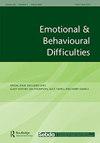School exclusion disparities in the UK: a view from Northern Ireland
IF 1.5
Q3 PSYCHOLOGY, EDUCATIONAL
引用次数: 1
Abstract
ABSTRACT Across the four UK jurisdictions, there are distinct disparities in exclusion rates of school students. Northern Ireland, alongside Scotland and Wales, has demonstrated over time, lower rates of permanent exclusions and temporary exclusions compared with England. This paper examines these disparities from the perspectives of representatives from various system-level educational bodies and third sector organisations representing children and families who experienced the exclusion process. The paper will also present policy and legal frameworks associated with exclusion in Northern Ireland. We interviewed 9 stakeholders, associated with practices of school exclusion in Northern Ireland, from a range of system-level education bodies and advocacy groups. Findings include positive strategies perceived to keep exclusion levels low, types of obstacles or resistance to anti-exclusion policy, participants’ perspectives on unofficial exclusion practice, and perspectives on official exclusion data. What emerges from interviews is a series of tensions between implementing a child-centred approach and diminishing support services and resources. We conclude that those working within the Northern Ireland education system, are committed to an inclusive approach. However, the development and implementation of effective supporting frameworks take time and consultation, and there is evidence of tension between the perceptions of those working at a system-level and those working in schools.英国的学校排斥差异:来自北爱尔兰的观点
在英国的四个司法管辖区,学校学生的排斥率有明显的差异。随着时间的推移,北爱尔兰、苏格兰和威尔士已经证明,与英格兰相比,永久和暂时被排除在外的比例较低。本文从代表遭受排斥过程的儿童和家庭的各个系统级教育机构和第三部门组织的代表的角度考察了这些差异。该文件还将介绍与北爱尔兰排斥有关的政策和法律框架。我们采访了9位与北爱尔兰学校排斥实践有关的利益相关者,他们来自一系列系统级教育机构和倡导团体。研究结果包括保持低排斥水平的积极策略,反排斥政策的障碍或阻力类型,参与者对非官方排斥实践的看法,以及对官方排斥数据的看法。从访谈中可以看出,在实施以儿童为中心的做法与支助服务和资源减少之间存在一系列紧张关系。我们的结论是,在北爱尔兰教育系统内工作的人致力于采用包容性方法。然而,制定和实施有效的支持框架需要时间和协商,而且有证据表明,在系统一级工作的人与在学校工作的人的看法之间存在紧张关系。
本文章由计算机程序翻译,如有差异,请以英文原文为准。
求助全文
约1分钟内获得全文
求助全文
来源期刊

EMOTIONAL AND BEHAVIOURAL DIFFICULTIES
PSYCHOLOGY, EDUCATIONAL-
CiteScore
1.80
自引率
10.00%
发文量
10
期刊介绍:
The central intention of Emotional & Behavioural Difficulties (EBDs) is to contribute to readers" understanding of social, emotional and behavioural difficulties, and also their knowledge of appropriate ways of preventing and responding to EBDs, in terms of intervention and policy. The journal aims to cater for a wide audience, in response to the diverse nature of the professionals who work with and for children with EBDs.
 求助内容:
求助内容: 应助结果提醒方式:
应助结果提醒方式:


